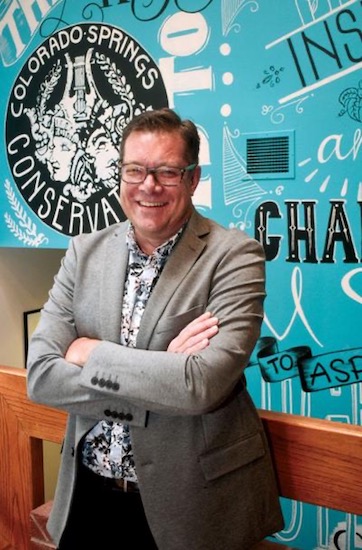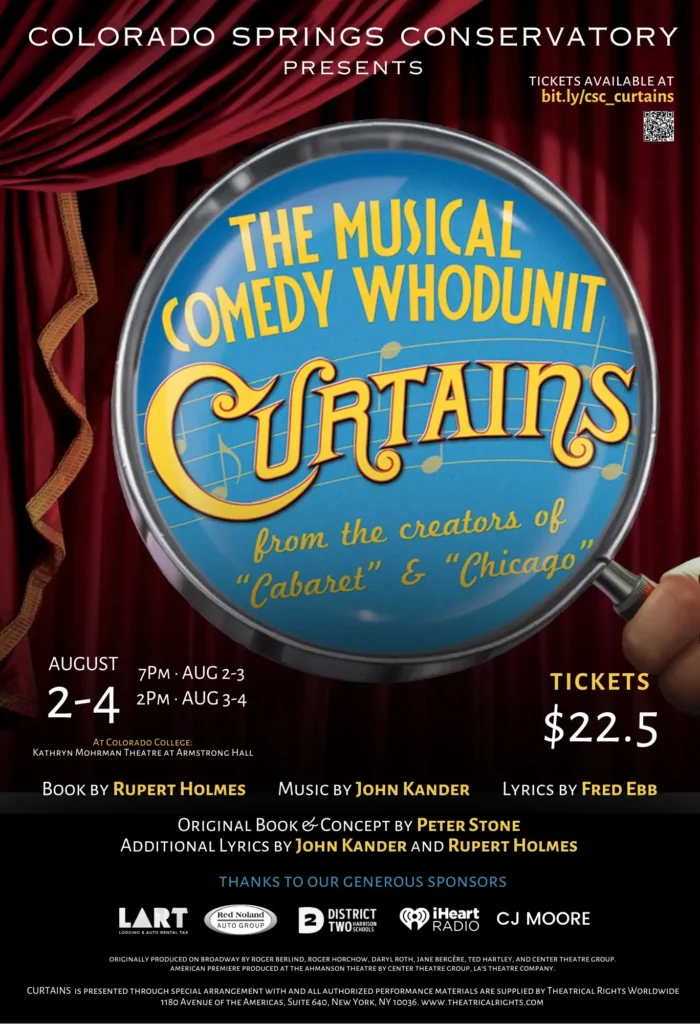This article was originally published in the Colorado Springs Business Journal

Nathan Halvorson has only been on the job as the new CEO of the Colorado Springs Conservatory for two and a half months, but he knows he has big shoes to fill. The Conservatory was founded in 1994 by Linda Weise, who headed the nonprofit for 28 years — you could hardly mention one without the other.
But last year Weise stepped down as the Conservatory’s CEO to become president of the Community Cultural Collective, the nonprofit established to restore the century-old Colorado Springs City Auditorium.
The Conservatory exists to develop young artistic performing creators in the Pikes Peak region across a variety of socioeconomic groups. Its computer labs are filled with iMacs with headphones and pro-level microphones. There are several pianos and other instruments throughout the building, and a dedicated space for recitals. In a thoroughly equipped recording booth, a young artist manipulates a multi-track Logic Pro composition while her instructor sings. In the basement, there’s a theater and a colorful space for the youngest artists to play and experiment.
With a background in theater and arts education, Halvorson was most recently associate director of Performing Arts and director of the Theatre School at the Colorado Springs Fine Arts Center. With a creative, professional career spanning 25 years, where does Halvorson start in this new position? “People ask me this all the time: What is your vision? What’s the five-year plan?” Halvorson said. “What I always said was, ‘If I told you what I wanted to do before I got there, that means I was making the decisions in a silo.’” In the conference room where the Business Journal met with Halvorson, the walls are filled with marked up white boards, the result of brainstorming sessions with the 40 creative experts who work at the Conservatory. He hasn’t been there long, but they’ve been busy figuring out what’s next.
Halvorson has an easily roused, loud laugh and usually wears a Superman ring, owing to his love for a character he says was created to give us hope during times of strife.
Your job at the Conservatory is to help kids write their own artistic origin stories, but what’s yours?
I was born in Madison, Wisconsin, but I lived in a small town called Sun Prairie until the fifth grade when my family moved to Sioux City, Iowa. I graduated from high school there, then I got my undergrad at the University of Northern Iowa in theater performance. Three or four days after graduation, I packed two suitcases and left for New York City.
Were you pent up to leave, like, ‘I can’t wait to get out of Iowa?’
Well, I don’t know if it was that so much as it was that back then, if you wanted to be in theater, it felt like it was New York or bust. Because I had studied at Circle in the Square Theatre School (in New York City) the summer before I graduated, I knew some folks and got a job as a casting assistant. I did that for a couple years, but then I was sitting around with all my friends and we were complaining about the state of our careers … and I said, ‘Why don’t we just start our own theater company so we can do our own stuff?’
“We’re going to give you the skills that you need to go out into the world and take over.”
So we started a theater company. Sometimes we’d have eight people in the audience, sometimes we’d have 75 people. We had a big success with a show called Two Girls from Vermont: A Dirty Pop Extravaganza!, which was based on Shakespeare’s The Two Gentlemen of Verona, where we used the music of NSYNC, Backstreet Boys and Britney Spears.
You sang and danced and acted — was this a vehicle to get into directing and production?
Well, back then it was ‘stay in your lane.’ That’s how it felt, but now the world is about knowing as much as you can and playing with everything to be a full, well-rounded artist. What’s so freeing and awesome for this next generation of students coming through the Conservatory is that there are so many options.
Did you always want to be an actor when you grew up?
I wanted to be in the theater from the beginning of time. My first-grade teacher was a local actor; she taught theater summer camps. I told my folks at a very young age, ‘I want to do that,’ and they were like, ‘OK.’ God bless them, they put me in every theater camp there was and really supported me from first grade until they passed. In my early years, I booked as an actor, but a lot of times you get into a rehearsal room and the actor isn’t asked their opinion, like it doesn’t matter. I thought, ‘Wait, you’ve collected all these brilliant talents in the room, we should all be making [this] together.’ Then I started to think, ‘Oh, I need to transition to directing.’
I focused almost exclusively on directing and choreography because I’m a dancer as well. Then somebody asked me if I wanted to choreograph something and I thought, ‘I can’t do that.’ But as any freelance artist knows, you don’t say no to a job, so I said, ‘Yeah, sure, I can do that.’ It’s become integral to how I see and make things and it all comes from saying yes one time. It changed my life. I’m so grateful that I was so poor because if I had been comfortable, maybe I would’ve said, ‘That’s not me.’ But I wasn’t. I had to take every job that was offered.
I went to the University of Iowa and got my master’s in Theatre Directing. They have this amazing writer’s program and I got to teach there while making all these really cool, strange, new plays. I took a job at [University of] Notre Dame teaching musical theater, then I was on the East Coast directing a couple shows. I did a couple of shows out here because I knew Scott Levy, who used to run the theater department at the Fine Arts Center, and I’ve been here ever since.
How did you end up applying for the CEO position at the Conservatory?
Theater education has been foundational to my work for the last 25 years of my professional career. I was on the road as an artist teaching everything from musical theater to Shakespeare and I was running an education department for the last decade at the Fine Arts Center. When I found out that this job was available, it felt like kismet, like it was the next thing I was supposed to do. And I was super fortunate that the board agreed.
I’m super invested in Colorado Springs, the Pikes Peak region, this state and particularly the young people here. This town has come a long way since I’ve lived here and I like to believe that I was playing an active role in that growth and I would like to continue to do that. I think creating a safe, inclusive space for artistic exploration is the most important thing for any thriving city.
What’s it been like adjusting to lead this prolific Colorado Springs institution, especially as people are fighting to defund the arts in schools?
When I was younger, I was in three choirs a day. The arts were important inside school systems then and I think they’re still important. We have many partnerships here at the Conservatory with different school districts where brilliant people are trying to make sure that art stays in the curriculum.
There are 40 people who make the Conservatory run each week that — just like in the rehearsal room — deserve to be heard and respected and honored. For the first few months, I was having one-on-one conversations with every single staff member where I listened to all their dreams, hopes, thoughts and history. There’s an exciting energy in the building right now where everyone’s writing the next chapter.
Based on your first few months so far, what would you say your vision for the Conservatory is?
I think when you take a deep dive into a three-decade-long program, you start to see where we turn the page and do what’s necessary in 2022. There are growing pains in that, but super fun ones. I have been trying to create the program of little Nathan’s dreams, and I feel so grateful for the opportunity to be in this position.
We want to be the premier multidisciplinary arts education space in the Pikes Peak region. We are a space for curiosity and we’re a space of excellence as well. Anyone who’s interested in any of the multidisciplinary tracks that we have here are welcome. There’s something we can teach, as art educators, about the ownership of self and taking up the space that you are given and that you’re allowed to speak your truth. As a young, queer person growing up, living inside of myself and inside my truth when I lived — and this is hyperbolic — in a cornfield in the ’90s, it wasn’t easy.
I still think that we live in a space of divisiveness in our culture right now. I want the students to walk through this door and feel safe in this space with these people and know that they are safe to express themselves and they are safe to fail — which is important — and that their colleagues and their mentors will lift them up.
We need art in our daily lives and working here allows me to use my skill set in the best way possible, which is future driven. If you have an interest in violin, piano, vocal performance, the recording arts, musical theater or in being a singer-songwriter, you can come here and we’re going to give you the skills that you need to go out into the world and take over.


